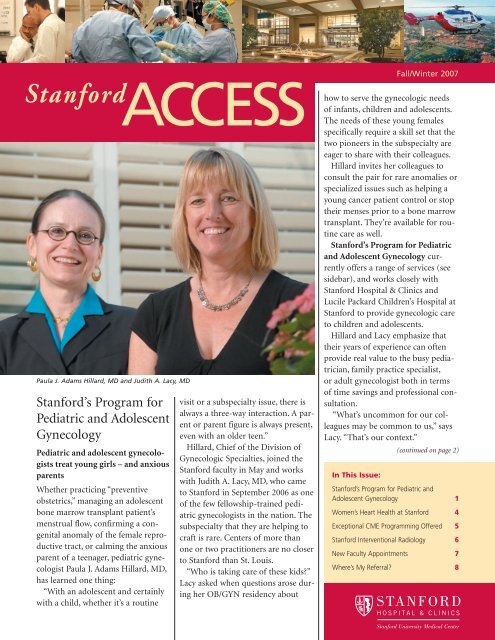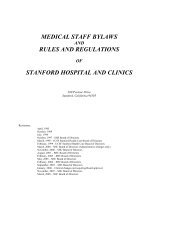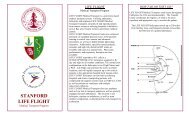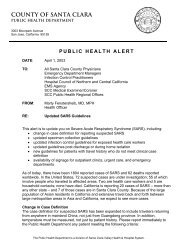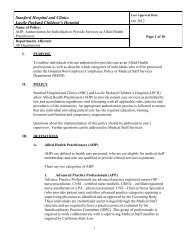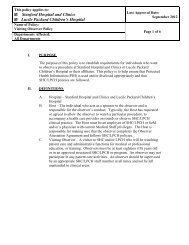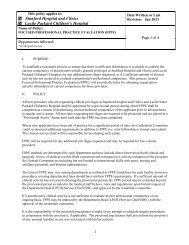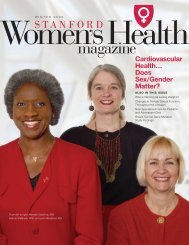Fall/Winter 2007 - Stanford Hospital & Clinics
Fall/Winter 2007 - Stanford Hospital & Clinics
Fall/Winter 2007 - Stanford Hospital & Clinics
You also want an ePaper? Increase the reach of your titles
YUMPU automatically turns print PDFs into web optimized ePapers that Google loves.
<strong>Stanford</strong><br />
Paula J. Adams Hillard, MD and Judith A. Lacy, MD<br />
<strong>Stanford</strong>’s Program for<br />
Pediatric and Adolescent<br />
Gynecology<br />
Pediatric and adolescent gynecologists<br />
treat young girls – and anxious<br />
parents<br />
Whether practicing “preventive<br />
obstetrics,” managing an adolescent<br />
bone marrow transplant patient’s<br />
menstrual flow, confirming a congenital<br />
anomaly of the female reproductive<br />
tract, or calming the anxious<br />
parent of a teenager, pediatric gynecologist<br />
Paula J. Adams Hillard, MD,<br />
has learned one thing:<br />
“With an adolescent and certainly<br />
with a child, whether it’s a routine<br />
ACCESS<br />
visit or a subspecialty issue, there is<br />
always a three-way interaction. A parent<br />
or parent figure is always present,<br />
even with an older teen.”<br />
Hillard, Chief of the Division of<br />
Gynecologic Specialties, joined the<br />
<strong>Stanford</strong> faculty in May and works<br />
with Judith A. Lacy, MD, who came<br />
to <strong>Stanford</strong> in September 2006 as one<br />
of the few fellowship-trained pediatric<br />
gynecologists in the nation. The<br />
subspecialty that they are helping to<br />
craft is rare. Centers of more than<br />
one or two practitioners are no closer<br />
to <strong>Stanford</strong> than St. Louis.<br />
“Who is taking care of these kids?”<br />
Lacy asked when questions arose during<br />
her OB/GYN residency about<br />
<strong>Fall</strong>/<strong>Winter</strong> <strong>2007</strong><br />
how to serve the gynecologic needs<br />
of infants, children and adolescents.<br />
The needs of these young females<br />
specifically require a skill set that the<br />
two pioneers in the subspecialty are<br />
eager to share with their colleagues.<br />
Hillard invites her colleagues to<br />
consult the pair for rare anomalies or<br />
specialized issues such as helping a<br />
young cancer patient control or stop<br />
their menses prior to a bone marrow<br />
transplant. They’re available for routine<br />
care as well.<br />
<strong>Stanford</strong>’s Program for Pediatric<br />
and Adolescent Gynecology currently<br />
offers a range of services (see<br />
sidebar), and works closely with<br />
<strong>Stanford</strong> <strong>Hospital</strong> & <strong>Clinics</strong> and<br />
Lucile Packard Children’s <strong>Hospital</strong> at<br />
<strong>Stanford</strong> to provide gynecologic care<br />
to children and adolescents.<br />
Hillard and Lacy emphasize that<br />
their years of experience can often<br />
provide real value to the busy pediatrician,<br />
family practice specialist,<br />
or adult gynecologist both in terms<br />
of time savings and professional consultation.<br />
“What’s uncommon for our colleagues<br />
may be common to us,” says<br />
Lacy. “That’s our context.”<br />
In This Issue:<br />
(continued on page 2)<br />
<strong>Stanford</strong>’s Program for Pediatric and<br />
Adolescent Gynecology 1<br />
Women’s Heart Health at <strong>Stanford</strong> 4<br />
Exceptional CME Programming Offered 5<br />
<strong>Stanford</strong> Interventional Radiology 6<br />
New Faculty Appointments 7<br />
Where’s My Referral? 8
2<br />
S tanford ACCESS <strong>Fall</strong>/<strong>Winter</strong> <strong>2007</strong><br />
The Pediatric and Adolescent Gynecology Program offers a<br />
range of services for the evaluation, diagnosis, and treatment<br />
of children and adolescents with gynecologic disorders including,<br />
but not limited to:<br />
Abnormal Bleeding<br />
• Frequent, irregular or heavy bleeding<br />
Adolescent Sexual Health and Contraception<br />
• Adolescents with complex medical problems who<br />
require contraception or hormonal therapy<br />
• New contraceptive options including implants and IUDs<br />
Breast Pathology<br />
• Asymmetry<br />
• Breast mass<br />
• Galactorrhea<br />
Congenital Genital Anomalies<br />
• Vaginal agenesis<br />
• Uterine and vaginal anomalies<br />
• External genitalia malformations<br />
• Imperforate hymen<br />
• Vaginal septa<br />
Genital Trauma<br />
• Traumatic injuries<br />
• Post assault injuries (after primary assault care completed)<br />
Menstrual Disorders<br />
• Primary and secondary amenorrhea<br />
• Oligomenorrhea<br />
• Dysmenorrhea<br />
Pelvic Masses<br />
• Ovarian cysts<br />
Pelvic Pain<br />
• Acute pelvic pain<br />
• Chronic pelvic pain<br />
• Endometriosis<br />
Reproductive Endocrinology<br />
• Hirsutism<br />
• Acne<br />
• Clitoromegaly<br />
• Polycystic ovary syndrome (PCOS)<br />
Vulvar, Vaginal and Cervical Lesions or Conditions<br />
• Vulvovaginitis<br />
• Lichen sclerosis<br />
• Condylomata/Genital warts<br />
• Abnormal pap smears<br />
• Bartholin’s gland cysts or abscesses<br />
• Vaginal foreign body<br />
Both Hillard and Lacy say they’ve<br />
learned that seemingly routine problems<br />
often require a closer look.<br />
“Even the most experienced adult<br />
gynecologist may not see many<br />
prepubertal girls, so when issues<br />
such as redness in the vulva occur, we<br />
can look beyond a yeast infection –<br />
often the cause in an adult but<br />
almost never the cause of irritation<br />
in a young girl – to find answers<br />
to questions we have addressed over<br />
and over again,” explains Hillard.<br />
“If a girl’s early menstrual periods<br />
are irregular or heavy, she will rarely<br />
complain. After all she has nothing<br />
directly to compare it to,” explains<br />
Hillard. “We need to ascertain<br />
whether the irregularity or heavy<br />
bleeding is within normal limits. In<br />
most cases, “it’s okay, she’s just a<br />
teenager,” is not the right answer.<br />
Lacy and Hillard note that the<br />
American College of Obstetrics and<br />
Gynecology recommends a visit (not<br />
necessarily a gynecologic exam) with<br />
a gynecologist while a girl is between<br />
the ages of 13 and 15, usually for preventive<br />
guidance.<br />
“Even if a young girl is perfectly<br />
comfortable with her lifelong pediatrician<br />
for most care, she may be<br />
quite uncomfortable telling that<br />
pediatrician that she is sexually active<br />
or asking why one breast is bigger<br />
than the other. In those instances,<br />
maybe we can help,” says Hillard.<br />
Working with parents and addressing<br />
concerns regarding confidentiality<br />
are part of the pantheon of psychosocial<br />
and psychosexual issues<br />
that the pediatric gynecologist confronts<br />
regularly.<br />
“Adolescent girls deserve privacy<br />
but you also don’t want to alienate<br />
the parent, who is legitimately concerned<br />
about the daughter’s health,”<br />
says Hillard.<br />
Hillard explains that often the<br />
daughter isn’t being as open about
S tanford ACCESS <strong>Fall</strong>/<strong>Winter</strong> <strong>2007</strong><br />
<strong>Stanford</strong>’s Program for<br />
Pediatric and Adolescent<br />
Gynecology currently offers a<br />
comprehensive range of<br />
services, and works closely<br />
with <strong>Stanford</strong> <strong>Hospital</strong> &<br />
<strong>Clinics</strong> and Lucile Packard<br />
Children’s <strong>Hospital</strong> at<br />
<strong>Stanford</strong> to offer a full range<br />
of clinical specialists,<br />
subspecialties,<br />
and research protocols.<br />
sexual matters as the parent thinks<br />
she is. “When you talk to the daughter<br />
alone you find she already needs<br />
contraception and she’s at risk for<br />
STDs. She hasn’t told mom this, even<br />
though mom says, ‘My daughter tells<br />
me everything.’ This happens over<br />
and over again.”<br />
“At the first visit, we encourage the<br />
daughter to discuss her contraceptive<br />
needs with her mother. We need to<br />
help draw that mom into the care,<br />
set the stage for daughter to talk to<br />
mom, but meanwhile you don’t want<br />
the daughter to get pregnant. At that<br />
visit we may recommend birth control<br />
pills for menstrual cramps and<br />
irregular periods. We never leave out<br />
the family context, whether the family<br />
is a traditional mom or a statesponsored<br />
guardian,” Hillard says.<br />
Mothers also need to understand<br />
that their own experiences are not<br />
necessarily parallel to what their<br />
daughters are going through. Hillard<br />
said a study she and her colleagues<br />
did while she was at the University of<br />
Cincinnati revealed that mothers suffering<br />
from PMS would assume –<br />
consistently incorrectly – that their<br />
daughters were experiencing the<br />
same thing.<br />
Frequently the parent worries even<br />
before the daughter can possibly<br />
know what’s wrong. Lacy points to a<br />
6-month-old infant’s mother who<br />
understandably was upset after an<br />
ultrasound revealed an incidental<br />
PAULA J. ADAMS HILLARD, MD<br />
Professor of Obstetrics and Gyencology<br />
Chief of the Division of Gynecologic Specialties<br />
finding that her daughter appeared to<br />
have a uterine anomaly. “In this case<br />
the finding transcended the limits of<br />
ultrasound technology and was not<br />
Paula Hillard obtained her medical degree from <strong>Stanford</strong> University School of<br />
Medicine and completed a residency in obstetrics and gynecology at the University<br />
of North Carolina, Chapel Hill. She then joined the faculty of the University<br />
of Virginia as Director of Ambulatory OB/GYN. Dr. Hillard was a member of the<br />
Department of OB/GYN at the University of Cincinnati from 1984-<strong>2007</strong>, and<br />
was the Director of Women’s Health for the University of Cincinnati College of<br />
Medicine. She has also served as Chief of Gynecology and Obstetrics at Cincinnati<br />
Children’s <strong>Hospital</strong> Medical Center, where she founded and directed the fellowship<br />
program in Pediatric and Adolescent Gynecology.<br />
She has been active on a number of national medical committees, including<br />
chair of the American College of Obstetricians and Gynecologists’ (ACOG)<br />
Committees on Patient Education, Adolescent Health, and Guidelines for<br />
Women’s Health. She is a past president of the North American Society for Pediatric<br />
and Adolescent Gynecology. She is an active contributor to the literature in<br />
adolescent gynecology and contraception with over 100 journal articles and<br />
abstracts published. She speaks frequently at national and international meetings<br />
and postgraduate courses on topics in ambulatory obstetrics and gynecology,<br />
pediatric and adolescent gynecology, cervical cancer screening, interpersonal violence,<br />
and primary care. Her clinical work has earned the designation as one of<br />
the “Best Doctors for Women” from Good Housekeeping Magazine.<br />
For consultation, Dr. Hillard can be reached at Paula.hillard@stanford.edu or<br />
(650) 725-5986.<br />
JUDITH A. LACY, MD<br />
Clinical Instructor<br />
Pediatric and Adolescent Gynecology<br />
Division of Gynecologic Specialties<br />
Department of Obstetrics and Gynecology<br />
After attending medical school at Oregon Health and Science University, Judith<br />
Lacy completed her OB/GYN residency at Duke University Medical Center. She<br />
then went on to complete a fellowship in pediatric and adolescent gynecology at<br />
the <strong>Hospital</strong> for Sick Children, affiliated with the University of Toronto.<br />
Dr. Lacy’s current interests include congenital anomalies of the female reproductive<br />
tract, ovarian preservation in adolescents and women undergoing<br />
chemotherapy, human papilloma virus and the HPV vaccine, polycystic ovarian<br />
syndrome, endometriosis in adolescents and adult women, management of menorrhagia<br />
in adolescents and adult women, and diagnosis and management of vulvovaginitis<br />
and vulvar dermatoses in the pediatric population.<br />
Judy can be reached at (650) 725-0601 or jalacy@stanford.edu for consultations<br />
with colleagues.<br />
3
4<br />
S tanford ACCESS <strong>Fall</strong>/<strong>Winter</strong> <strong>2007</strong><br />
“Colleagues are invited<br />
to consult the pair for rare<br />
anomalies or specialized<br />
treatment issues such<br />
as helping a young cancer<br />
patient control or stop<br />
menses prior to bone marrow<br />
transplant”<br />
necessarily definitive,” Lacy notes,<br />
“but it illustrates the point that parents<br />
almost invariably ask, ‘What is<br />
my daughter’s childbearing potential?’<br />
following any finding that presumably<br />
compromises fertility.”<br />
“Beyond that, the girls themselves<br />
want information now. And fertility<br />
education as an adolescent is a lot<br />
better to receive than struggling with<br />
years of infertility as an adult,” Lacy<br />
adds.<br />
A whole range of conditions,<br />
including polycystic ovarian syndrome,<br />
or endometriosis, often manifest<br />
in adolescents but aren’t diagnosed<br />
until much later – sometimes<br />
not until the woman tries to conceive<br />
and can’t. “That’s a strong<br />
argument for early diagnosis, treatment,<br />
and counseling,” Hillard says.<br />
Because the field of pediatric<br />
gynecology is new, Hillard and Lacy<br />
say they had few role models when<br />
they entered their profession. During<br />
her first faculty appointment at<br />
the University of Virginia, Hillard<br />
said pediatricians channeled their<br />
gynecology patients to her as the<br />
OB/GYN department’s only woman<br />
gynecologist.<br />
In 1982, she and other pediatric<br />
and adolescent gynecologists around<br />
the country founded the North<br />
American Society of Pediatric and<br />
Adolescent Gynecology.<br />
Both Hillard and Lacy are available<br />
to accept referrals from their pediatric,<br />
family medicine, and gyneco-<br />
logic colleagues, and are available to<br />
consult with a colleague on a child’s<br />
care. Physicians may reach Lacy or<br />
Hillard via the physician referral hotline:<br />
(800) 756-5000, or email referral@stanfordmed.org.<br />
■<br />
Women’s Heart Health<br />
at <strong>Stanford</strong><br />
<strong>Stanford</strong> is a nationally recognized<br />
center in cardiovascular medicine<br />
and has recently made a commitment<br />
to improving the cardiovascular<br />
health of women. The newly<br />
created outpatient clinic, Women’s<br />
Heart Health at <strong>Stanford</strong>,is<br />
designed to specifically address the<br />
needs of women with known or suspected<br />
cardiovascular disease (CVD).<br />
While women have a proportionally<br />
lower prevalence of cardiovascular<br />
disease than men and tend to develop<br />
it later in life, it remains underappreciated<br />
that every year more<br />
women than men die of CVD, and<br />
that it is the eventual cause of death<br />
in one out of every two women in<br />
the United States. “What we know<br />
about CVD and how we treat it has<br />
grown out of a body of research<br />
focused primarily on men. We have<br />
assumed that we could take these<br />
findings and apply them to women,<br />
but the sex gap in outcomes would<br />
suggest otherwise,” says Dr. Jennifer<br />
Tremmel, Clinical Director of<br />
Women’s Heart Health at <strong>Stanford</strong>.<br />
“There is a growing body of sexbased<br />
research in cardiology that is<br />
evolving into a new paradigm for<br />
how we might diagnose and treat<br />
women differently from how we<br />
diagnose and treat men. The hope is<br />
that if we apply this knowledge, and<br />
JENNIFER A. TREMMEL, MD, SM<br />
Instructor of Cardiovascular Medicine<br />
Clinical Director, Women’s Heart<br />
Health at <strong>Stanford</strong><br />
Director of <strong>Stanford</strong>’s Secondary Prevention<br />
Program<br />
Dr. Jennifer<br />
Tremmel<br />
received her<br />
medical<br />
degree from<br />
the University<br />
of Iowa, completed<br />
her<br />
internship<br />
and residency at Dartmouth-Hitchcock<br />
Medical Center, earned a master’s<br />
degree in epidemiology from<br />
the Harvard School of Public<br />
Health, and completed fellowships<br />
in cardiovascular medicine and<br />
interventional cardiology at <strong>Stanford</strong><br />
University Medical Center.<br />
She is Clinical Director of a newly<br />
developed clinic, Women’s Heart<br />
Health at <strong>Stanford</strong>,designed to<br />
specifically address the needs of<br />
women with known or suspected<br />
cardiovascular disease.<br />
Dr. Tremmel’s research interests<br />
include sex differences in coronary<br />
artery disease. She is currently evaluating<br />
the relative occurrence of<br />
endothelial dysfunction and<br />
microvascular disease in women<br />
compared with men to determine<br />
whether women have a unique coronary<br />
pathophysiology.<br />
For appointments to Women’s<br />
Heart Health at <strong>Stanford</strong>, call Mary<br />
Nejedly, NP at (650) 736-0516. Dr.<br />
Tremmel can also be reached directly<br />
at (650) 704-4740 or<br />
jtremmel@cvmed.stanford.edu.<br />
care for women in a sex-specific<br />
manner, that we will eventually improve<br />
their outcomes.”<br />
Women’s Heart Health at <strong>Stanford</strong><br />
is intended to do just that. The clinic<br />
offers evidence-based, sex-specific,<br />
personalized, and comprehensive<br />
care including primary and secondary<br />
prevention, diagnosis, and
S tanford ACCESS <strong>Fall</strong>/<strong>Winter</strong> <strong>2007</strong><br />
“We pay particular attention<br />
to risk factors known<br />
to be important in women<br />
such as a low HDL, high<br />
triglycerides, and excess<br />
weight contributing to insulin<br />
resistance and diabetes”<br />
treatment of cardiovascular disease.<br />
“Our experience so far is that<br />
women are becoming increasingly<br />
aware that they have unique issues<br />
when it comes to cardiovascular<br />
health, and they are seeking<br />
providers who are attuned to these<br />
sex-based differences.”<br />
As a cardiovascular clinic, Women’s<br />
Heart Health at <strong>Stanford</strong> is aimed at<br />
those women with known or suspected<br />
CVD.“The presentations for<br />
heart disease that we have traditionally<br />
called ‘atypical’ are often very<br />
EXCEPTIONAL CME<br />
PROGRAMMING OFFERED<br />
BY STANFORD HOSPITAL<br />
& CLINICS’ DEPARTMENT<br />
OF CONTINUING MEDICAL<br />
EDUCATION<br />
www.cme.stanfordhospital.com<br />
(650) 724-9549<br />
shc-cme@stanfordmed.org<br />
GI Cancers<br />
October 18-20, <strong>2007</strong><br />
Mauna Lani Resort, Kohala Coast,<br />
Big Island of Hawaii<br />
2nd Annual Cardiology for<br />
the Internist: Clinical Update<br />
October 27, <strong>2007</strong><br />
Four Seasons Hotel, Palo Alto,<br />
California<br />
Reconstructive Surgery at<br />
<strong>Stanford</strong>: Craniofacial Update<br />
November 3, <strong>2007</strong><br />
Hotel Sofitel, Redwood City, California<br />
Electrophysiology in the West<br />
Summit<br />
November 30-December 2, <strong>2007</strong><br />
La Playa Hotel, Carmel, California<br />
typical for women. We hear them in<br />
our clinic all of the time.” The women’s<br />
clinic orders diagnostic tests<br />
that are felt to be most accurate in<br />
women and will perform coronary<br />
angiography when deemed appropriate.<br />
“Women are less likely than men<br />
to have obstructive coronary disease<br />
on angiography, but may be more<br />
likely to have vascular abnormalities<br />
such as endothelial dysfunction and<br />
Hand Surgery at Tahoe<br />
January 25-27, 2008<br />
Hyatt Lake Tahoe, Incline Village,<br />
Nevada<br />
21st Annual Anesthesia<br />
Update<br />
February 17-22, 2008<br />
Big Sky Resort, Big Sky, Montana<br />
<strong>Stanford</strong> Morbid Obesity<br />
Update<br />
March 3-5, 2008<br />
Turtle Bay Resort, Oahu, Hawaii<br />
3rd Annual Complex<br />
Cardiovascular Patient<br />
Management<br />
May 19-21, 2008<br />
Oahu, Hawaii<br />
Bi-Annual Urogynecology<br />
Update<br />
August 1, 2008<br />
<strong>Stanford</strong>, California<br />
For more information:<br />
www.cme.stanfordhospital.com<br />
(650) 724-9549<br />
email shc-cme@stanfordmed.org<br />
microvascular disease,” reports Dr.<br />
Tremmel. “We test for these abnormalities<br />
in the cath lab in symptomatic<br />
patients whose coronary arteries<br />
appear normal. Telling patients<br />
with angina-like symptoms and normal<br />
appearing coronary arteries that<br />
there’s nothing wrong with their<br />
heart may be very inaccurate.” It also<br />
leads to frustration in both the physician<br />
and patient when no other etiology<br />
can be found. Currently, invasive<br />
diagnostic vascular function studies<br />
are performed only at select hospitals<br />
around the country. Patients coming<br />
to <strong>Stanford</strong> are offered this state-ofthe-art<br />
approach, which can be<br />
extremely helpful in guiding treatment<br />
when abnormalities are found.<br />
All women coming to Women’s<br />
Heart Health at <strong>Stanford</strong> receive a<br />
comprehensive risk assessment and<br />
are counseled on lifestyle and risk<br />
factor modification. “We pay particular<br />
attention to risk factors known to<br />
be important in women such as a low<br />
HDL, high triglycerides, and excess<br />
weight contributing to insulin resistance<br />
and diabetes,” says Mary Nejedly,<br />
the clinic’s nurse practitioner.<br />
Helping women to understand their<br />
risk and getting them to be proactive<br />
in following a healthy diet and exercising<br />
regularly is a major focus. “We<br />
also address psychosocial issues such<br />
as stress, anxiety, and depression,<br />
which are often overlooked, and are<br />
5
6<br />
S tanford ACCESS <strong>Fall</strong>/<strong>Winter</strong> <strong>2007</strong><br />
adamant about secondary prevention,”<br />
adds Dr. Tremmel. “Beyond<br />
diagnosing and treating their coronary<br />
artery disease, we make sure<br />
that they get to cardiac rehab and<br />
receive teaching about a hearthealthy<br />
diet and weight control.”<br />
In addition to Dr. Tremmel and<br />
Mary Nejedly, Women’s Heart<br />
Health at <strong>Stanford</strong> has a network of<br />
providers who are committed to providing<br />
sex-specific cardiovascular<br />
care. Dr. Ingela Schnittger specializes<br />
in heart imaging, Dr. Hannah Valentine<br />
specializes in heart transplantation,<br />
and Dr. Paul Wang specializes<br />
in electrophysiology. Beyond that, an<br />
internal referral network has been<br />
established so that women continue<br />
to have sex-specific care once they<br />
become patients of the clinic.<br />
“Patients often need referrals to a<br />
dietician, a cardiothoracic surgeon, a<br />
psychologist, an endocrinologist, a<br />
gynecologist, and so on. We have a<br />
group of excellent <strong>Stanford</strong> physicians<br />
who keep current on sex-specific<br />
issues in their area of expertise<br />
and serve as great resources in the<br />
care of our women patients.”<br />
For appointments to Women’s<br />
Heart Health at <strong>Stanford</strong>, call Mary<br />
Nejedly, NP at (650) 736-0516. Dr.<br />
Tremmel can be reached directly at<br />
(650) 704-4740 or<br />
jtremmel@cvmed.stanford.edu.<br />
Dr. Tremmel will be speaking on<br />
Women and Heart Disease at the<br />
2nd Annual Cardiology for the Internist:<br />
Clinical Update,a continuing<br />
medical education conference to be<br />
held October 27, <strong>2007</strong>, at the Four<br />
Seasons Hotel-Silicon Valley at East<br />
Palo Alto, California. For more information,<br />
call (650) 724-9549, or visit<br />
www.cme.stanfordhospital.com. ■<br />
<strong>Stanford</strong> Interventional<br />
Radiology<br />
<strong>Stanford</strong> Interventional Radiology<br />
performs innovative treatments<br />
for acute and chronic deep venous<br />
thrombosis (DVT)<br />
Most patients with acute DVT are prescribed<br />
anticoagulation therapy to<br />
prevent thrombus propagation. Thrombus<br />
dissolution is left to the patient’s<br />
natural fibrinolytic system. The literature<br />
suggests that despite anticoagulation<br />
therapy, in patients with acute<br />
proximal DVT, only 32% of people<br />
are clot-free after three months and<br />
50-60% at six to 12 months. Recent<br />
prospective studies have found that<br />
49%-60% of patients with proximal<br />
DVT will develop Post-Thrombotic<br />
Syndrome (PTS), a long term sequellae<br />
of DVT. Early DVT thrombolysis<br />
has demonstrated the benefit of a<br />
reduction in postthrombotic syndrome<br />
and early symptom relief.<br />
<strong>Stanford</strong> Interventional Radiology<br />
is using a new state-of-the-art device<br />
that delivers a very low dose of tPA directly<br />
into the thrombus. The device<br />
then macerates the clot. An aspiration<br />
lumen is used at the end of the<br />
procedure to remove thrombus fragments.<br />
This technology, called “isolated<br />
thrombolysis,” enables safe and<br />
effective DVT thrombolysis in a single<br />
procedure and can even be done<br />
as an outpatient. The procedure is<br />
minimally invasive, requiring only a<br />
band-aid when done.<br />
Appropriate patients are those with<br />
extensive thrombus causing significant<br />
pain and swelling as well as<br />
those patients with thrombus resistant<br />
to anticoagulation therapy. Ideal<br />
patients are those diagnosed within<br />
seven days. This would include outpatients<br />
on low-molecular weight<br />
heparin and coumadin. Upper<br />
Isolated thrombolysis<br />
enables safe and effective<br />
DVT thrombolysis in a single<br />
procedure and can even be<br />
done as an outpatient.<br />
The procedure is minimally<br />
invasive, requiring only a<br />
band-aid when done.<br />
extremity thrombosis patients can<br />
also be treated with this technique.<br />
<strong>Stanford</strong> Interventional Radiology<br />
has also pioneered new techniques to<br />
treat patients with significant<br />
swelling and discomfort of the upper<br />
and lower extremities due to chronic<br />
DVT, known as Post-Thrombotic<br />
Syndrome (PTS). This technique<br />
does not involve the use of thrombolytic,<br />
but relies exclusively on<br />
opening the occluded vessels with<br />
the placement of stents. We have<br />
been successful in opening veins that<br />
have been occluded for up to 25 years,<br />
Bilateral lower extremity venogram shows complete occlusion of the iliac veins<br />
bilaterally with masive pelvic collaterals. Following stenting, reconstructed venous<br />
system demonstrates in-line flow from legs into inferior vena cava.
S tanford ACCESS <strong>Fall</strong>/<strong>Winter</strong> <strong>2007</strong><br />
providing dramatic relieve to the<br />
patient.<br />
We are excited to offer DVT<br />
patients a therapy that provides<br />
immediate relief of symptoms and<br />
potentially a reduced risk of the long<br />
term sequellae. For consultation on<br />
any patient whom you believe may<br />
be a candidate for this procedure,<br />
please call (650) 575-8674. For evaluation<br />
in the clinic, call 650-72-<br />
IRDOC (650-724-7362). ■<br />
New Faculty<br />
Appointments<br />
EMILIE V. CHEUNG, MD<br />
Assistant Professor, Department of<br />
Orthopaedic Surgery<br />
Dr. Cheung specializes<br />
in reconstructiveprocedures<br />
of the<br />
shoulder and<br />
elbow, including<br />
fractures, joint<br />
replacements, rotator cuff repair, cartilage<br />
and soft tissue injuries, and<br />
arthroscopic procedures.<br />
She completed her orthopaedic<br />
surgery residency at Drexel University<br />
in Philadelphia, PA, and her fellowship<br />
in shoulder and elbow surgery<br />
at the Mayo Clinic.<br />
Her research has focused on clinical<br />
outcomes following revision of<br />
total shoulder replacements, revision<br />
of total elbow replacements, anterior<br />
capsular stabilization for instability<br />
of the shoulder, and complications<br />
following shoulder and elbow reconstruction<br />
procedures.<br />
Dr. Cheung’s current research<br />
involves investigating localized osteoporosis<br />
in the upper extremity after<br />
arthroplasty. She can be reached at<br />
evcheung@stanford.edu or (650)<br />
736-7804. For appointments, call<br />
(650) 498-7555.<br />
JASON T. LEE, M.D.<br />
Assistant Professor of Surgery, Division<br />
of Vascular Surgery<br />
Associate Program Director, Vascular<br />
Surgery Fellowship<br />
Jason Lee received<br />
his undergraduate<br />
degree<br />
from Caltech and<br />
graduated from<br />
medical school at<br />
UC San Diego.<br />
He went on to complete his general<br />
surgery training at Harbor-UCLA<br />
Medical Center, and came to <strong>Stanford</strong><br />
for his vascular and endovascular<br />
surgery fellowship. He joined the<br />
<strong>Stanford</strong> faculty as Assistant Professor<br />
of Surgery.<br />
Dr. Lee’s clinical interests include<br />
endovascular treatment of abdominal<br />
and thoracic aortic aneurysms, complex<br />
open vascular reconstructions,<br />
carotid angioplasty and stenting, percutaneous<br />
interventions for peripheral<br />
vascular disease, and thoracic outlet<br />
syndrome.<br />
He currently serves as the Principle<br />
Investigator for several clinical trials<br />
involving next-generation stent-grafts<br />
for treatment of abdominal aortic<br />
aneurysms, carotid stenting, and<br />
atherectomy devices. He is<br />
developing a broad-based endovascular<br />
training curriculum within the<br />
newly opened Goodman Simulation<br />
Center that will serve to augment the<br />
education of future medical students,<br />
residents, fellows, and community<br />
surgeons.<br />
Dr. Lee can be reached at (650)<br />
724-8292 (office) or (650) 725-5227<br />
(clinic). Clinical and research highlights<br />
can be found on http://vascular.stanford.edu<br />
or by emailing<br />
jtlee@stanford.edu.<br />
MARC R. SAFRAN, MD<br />
Associate Director of Sports Medicine<br />
Director, Sports Medicine Fellowship<br />
Professor, Orthopaedic Surgery<br />
Marc Safran specializes<br />
in sports<br />
medicine including<br />
arthroscopic<br />
and ligament<br />
reconstructive<br />
surgery of the<br />
shoulder, elbow, hip, and knee, and<br />
articular cartilage regeneration.<br />
He completed medical school at<br />
Duke University, his orthopaedic surgery<br />
residency at UCLA, and his<br />
sports medicine and shoulder surgery<br />
fellowship at the University of Pittsburgh.<br />
He has served as a team physician<br />
for various collegiate teams since<br />
1993, and is actively involved with<br />
professional tennis and basketball.<br />
Prior to joining <strong>Stanford</strong> in the<br />
spring of <strong>2007</strong>, Dr. Safran was the<br />
Chief of Sports Medicine at UCSF,<br />
where he also served as a team physician<br />
for UC Berkeley.<br />
Dr. Safran can be reached at (650)<br />
723-9815 or msafran@stanford.edu.<br />
JEFFREY YAO, MD<br />
Assistant Professor of the Robert A.<br />
Chase Hand & Upper Limb Center,<br />
Department of Orthopaedic Surgery<br />
Jeffrey Yao received<br />
his MD from<br />
Cornell University<br />
Medical College,<br />
completed his<br />
internship and<br />
residency in orthopaedic<br />
surgery at Albert Einstein College<br />
of Medicine, and did his hand<br />
and upper extremity fellowship at the<br />
Philadelphia Hand Center at Thomas<br />
Jefferson University <strong>Hospital</strong>.<br />
7
8<br />
S tanford ACCESS <strong>Fall</strong>/<strong>Winter</strong> <strong>2007</strong><br />
His interests include performing<br />
and researching minimally invasive<br />
and arthroscopic treatment alternatives<br />
for common hand, wrist, elbow<br />
and shoulder disorders, treating<br />
sports-related, traumatic and degenerative<br />
conditions of the hand, wrist,<br />
forearm, elbow, and shoulder, and<br />
biologic augmentation of tendon<br />
repair strategies utilizing stem cells.<br />
Contact Dr. Yao at<br />
jyao@stanford.edu, or (650) 723-6796.<br />
WEI ZHOU, MD<br />
Associate Professor of Surgery,<br />
Division of Vascular Surgery<br />
Vascular Surgery Section Chief,<br />
VAPAHCS<br />
Dr. Zhou earned<br />
her undergraduate<br />
degree at the<br />
University of<br />
California-San<br />
Diego, her medical<br />
degree at New<br />
York Medical College, and her general<br />
surgery training at UC San Diego<br />
Medical Center. After completing a<br />
vascular surgery fellowship at the<br />
Baylor College of Medicine, Dr. Zhou<br />
joined the Baylor faculty as an Assis-<br />
<strong>Stanford</strong><br />
ACCESS<br />
<strong>Stanford</strong> University Medicine<br />
Outpatient Center<br />
MC 5502<br />
420 Broadway, 3rd Floor<br />
Redwood City, CA 94063<br />
<strong>Fall</strong>/<strong>Winter</strong> <strong>2007</strong><br />
Rose Anne Petersen<br />
Director, Physician Relations<br />
Sheila Tost<br />
Editor, <strong>Stanford</strong> Access<br />
Manager, Continuing Medical<br />
Education<br />
tant Professor of Surgery and as an<br />
Associate Program Director for the<br />
Vascular Surgery Fellowship. She<br />
joined the <strong>Stanford</strong> University Medical<br />
Center in July <strong>2007</strong>.<br />
Dr. Zhou’s focus is on a variety of<br />
endovascular interventions including<br />
endovascular treatments of carotid<br />
diseases, complex aortic aneurysms,<br />
lower extremity occlusive diseases,<br />
and venous diseases.<br />
Where’s My Referral?<br />
In addition to her clinical responsibilities,<br />
Dr. Zhou will continue to<br />
pursue her research interests and<br />
serve as a Principal Investigator on<br />
several clinical trials examining new<br />
therapeutic strategies for management<br />
of cerebrovascular diseases,<br />
claudication and limb salvage, and<br />
treatment of aortic aneurysms.<br />
Dr. Zhou can be reached at (650)<br />
849-0507 or weizhou@stanford.edu.<br />
Did you know you can fax patient referrals to ANY <strong>Stanford</strong><br />
clinic using just one number?<br />
The <strong>Stanford</strong> Referral Center fax number is the convenient,<br />
single point of clinic access for you and your staff.<br />
The Referral Center staff has the ability to:<br />
• Scan your referral, preventing loss<br />
• Confirm receipt back to you by fax<br />
• Track your patient referrals until scheduled<br />
• Notify you of your patient’s appointment<br />
Referring physicians and their staff have indicated this<br />
service enhancement has improved communication with the<br />
clinics and facilitates a process that eliminates guesswork<br />
once the patient referral leaves your office.<br />
Please fax all referrals to (650) 320-9443 and experience<br />
our improved service!<br />
<strong>Stanford</strong> <strong>Hospital</strong> & <strong>Clinics</strong> saved the following resources by using New Leaf Sakura 100, made with 100%<br />
post-consumer waste, and processed chlorine free, designated Ancient Forest Friendly and manufactured with<br />
electricity that is offset with Green-e® certified renewable energy certificates: 20 fully grown trees, 6,637<br />
gallons of water, 11 million BTU of energy, and 958 pounds of solid waste and 1,862 pounds of greenhouse<br />
gases. www.newleafpaper.com Calculations based on research by Environmental Defense and other members of the paper Task Force.<br />
NON-PROFIT<br />
ORGANIZATION<br />
U.S. POSTAGE PAID<br />
PALO ALTO, CA<br />
PERMIT NO. 188


